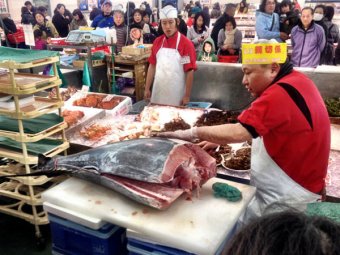
 With Valentine’s Day just around the corner, I know some of you are planning a homemade sushi dinner. Whether this is your first time or you’re a seasoned pro, making sushi at home can be simple, fun, and rewarding. I’ve written before on how to make sushi rolls and Adrianna recently did a post on temaki, but the question I get asked the most is some version of “how do I know if the fish at my store is safe to eat raw?”.
With Valentine’s Day just around the corner, I know some of you are planning a homemade sushi dinner. Whether this is your first time or you’re a seasoned pro, making sushi at home can be simple, fun, and rewarding. I’ve written before on how to make sushi rolls and Adrianna recently did a post on temaki, but the question I get asked the most is some version of “how do I know if the fish at my store is safe to eat raw?”.
The term “sushi-grade” is often tossed around to imply some level of freshness, but in the US, there’s no regulation around the use of the phrase, so it can be used to describe anything. That said, most stores aren’t in the business of getting their customers sick, so they usually reserve the label for their freshest fish.
Unfortunately, just because it’s fresh doesn’t mean it’s safe to eat raw. Some fish, such as salmon, contain parasites that will make you sick unless they’ve been destroyed. Another potential problem is cross-contamination. This happens when “sushi-grade” fish gets cut on the same cutting board or using the same knife or handled with the same gloves as non-sushi-grade fish. If your fishmonger is storing unwrapped sushi-grade fish in the same refrigerated case as non-sushi-grade fish, this should be a big red flag.
 For fish that contain parasites, the FDA provides guidance under their Parasite Destruction Guarantee. This states in part that fish intended to be consumed raw must be “frozen and stored at a temperature of -20°C (-4°F) or below for a minimum of 168 hours (7 days)”.
For fish that contain parasites, the FDA provides guidance under their Parasite Destruction Guarantee. This states in part that fish intended to be consumed raw must be “frozen and stored at a temperature of -20°C (-4°F) or below for a minimum of 168 hours (7 days)”.
Cross contamination is a bigger issue. Because most stores don’t sell a high enough volume of fish intended to be eaten raw, they don’t maintain a separate space for handling their “sushi-grade” fish. What’s worse, because tuna is such a large fish, most stores don’t deal with whole tuna, they buy them pre-filleted, which means you have to take into consideration not only the stores handling of the fish, but their supplier’s handling of the fish as well.
Ultimately, what it comes down to is how much you trust your fishmonger to understand the best practices for handling fish meant to be consumed raw, and how much they trust their suppliers to hold the same standards. Here are a few things to remember when buying fish to ensure you have a safe and delicious sushi-dinner:
- Observe and see for yourself whether they’re cutting their sushi-grade fish on the same cutting board as their other fish, without changing gloves or disinfecting their knife and board first.
- Ask whether they fillet the fish you’re looking to buy themselves, or if they’re getting them pre-filleted.
- If you are buying salmon, ask if they can produce logs that show the times and temperatures that the fish was frozen.
If you can’t find a local place you can trust with raw fish, why not try filling your sushi with vegetables, cooked fish, or even meat. California Rolls and Caterpillar Rolls may not be traditional, but that doesn’t make them any less delicious!
Marc Matsumoto is a culinary consultant and recipe repairman who shares his passion for good food through his website norecipes.com. For Marc, food is a life long journey of exploration, discovery and experimentation and he shares his escapades through his blog in the hopes that he inspires others to find their own culinary adventures. Marc’s been featured in the New York Times, Wall Street Journal, and USA Today, and has made multiple appearances on NPR and the Food Network.









